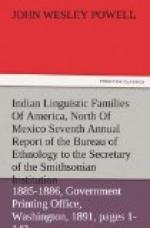In treating of the languages of North America it has been suggested that the names adopted should be the names by which the people recognize themselves, but this is a rule of impossible application, for where the branches of a stock diverge very greatly no common name for the people can be found. Again, it has been suggested that names which are to go permanently into science should be simple and euphonic. This also is impossible of application, for simplicity and euphony are largely questions of personal taste, and he who has studied many languages loses speedily his idiosyncrasies of likes and dislikes and learns that words foreign to his vocabulary are not necessarily barbaric.
Biologists have decided that he who first distinctly characterizes and names a species or other group shall thereby cause the name thus used to become permanently affixed, but under certain conditions adapted to a growing science which is continually revising its classifications. This law of priority may well be adopted by philologists.
By the application of the law of priority it will occasionally happen that a name must be taken which is not wholly unobjectionable or which could be much improved. But if names may be modified for any reason, the extent of change that may be wrought in this manner is unlimited, and such modifications would ultimately become equivalent to the introduction of new names, and a fixed nomenclature would thereby be overthrown. The rule of priority has therefore been adopted.
Permanent biologic nomenclature dates from the time of Linnaeus simply because this great naturalist established the binominal system and placed scientific classification upon a sound and enduring basis. As Linnaeus is to be regarded as the founder of biologic classification, so Gallatin may be considered the founder of systematic philology relating to the North American Indians. Before his time much linguistic work had been accomplished, and scholars owe a lasting debt of gratitude to Barton, Adelung, Pickering, and others. But Gallatin’s work marks an era in American linguistic science from the fact that he so thoroughly introduced comparative methods, and because he circumscribed the boundaries of many families, so that a large part of his work remains and is still to be considered sound. There is no safe resting place anterior to Gallatin, because no scholar prior to his time had properly adopted comparative methods of research, and because no scholar was privileged to work with so large a body of material. It must further be said of Gallatin that he had a very clear conception of the task he was performing, and brought to it both learning and wisdom. Gallatin’s work has therefore been taken as the starting point, back of which we may not go in the historic consideration of the systematic philology of North America. The point of departure therefore is the year 1836, when Gallatin’s “Synopsis of Indian Tribes” appeared in vol. 2 of the Transactions of the American Antiquarian Society.




